How to Make Your Own Homemade Italian Seasoning Blend
Once you switch to this homemade Italian seasoning blend you’ll never buy store-bought again. It takes mere minutes to make but will enhance so many family favorites from soups to salads, poultry to pasta. Made using dried herbs it’s quick, affordable, and long-lasting.
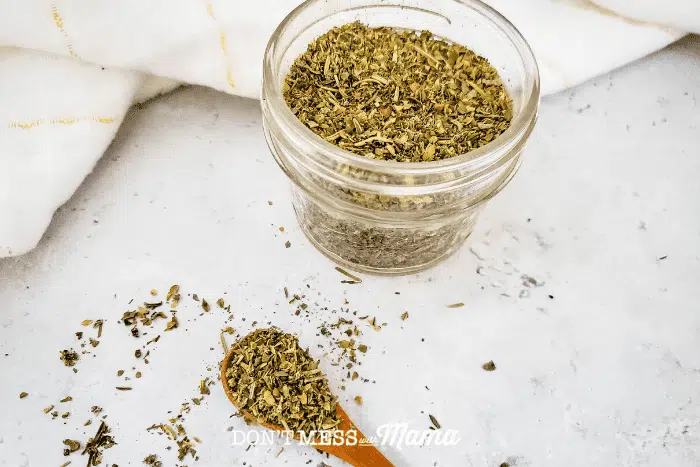
This post contains affiliate links. Please read my affiliate disclosure.
This homemade Italian Seasoning Blend is not only easy to make, but it will save you time and effort in the kitchen. Made using herbs already in your pantry, it’s a simple but powerful blend that adds Mediterranean flavor in minutes.
Making your own stapes is one of my favorite ways to save time in the kitchen, it also avoids my countertop getting cluttered as I have one jar that does the job of many. Not only do you no longer have to take out each individual herb and spice jar, but you will no longer need to measure each individual herb either.
With oregano, basil, thyme, rosemary, sage and marjoram, this easy Italian seasoning offers a balanced blend with the perfect amount of each herb to avoid flavor overwhelm. Best of all, as it’s homemade you can tailor it to your taste – adding extra of your favorite flavors or removing those you don’t rate.
What Is Italian Seasoning?
As the name describes, Italian seasoning is a blend of dried herbs that is used in Italian recipes. You’ll find various varieties in the grocery store, though generally, they all contain a combination of three staple herbs: oregano, basil and rosemary. Then, some (like this recipe) also include thyme, sage and marjoram.
Others may also include onion powder, red pepper flakes or garlic. I find not every recipe calls for these ingredients so I add these individually as and when a recipe requires it so you can control the flavors.
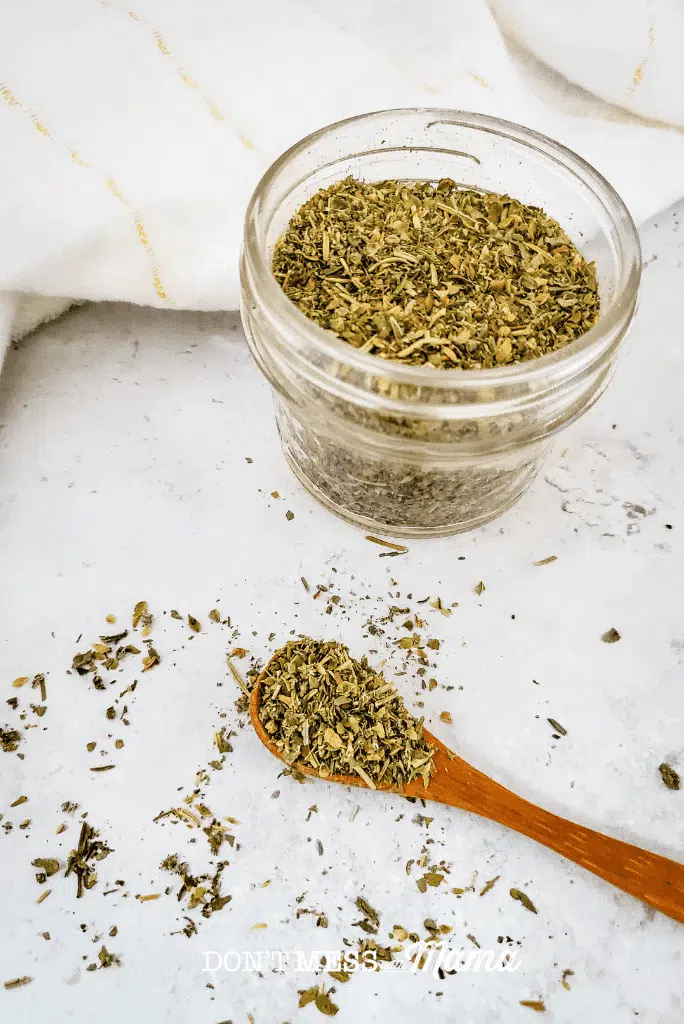
About The Ingredients
I recommend buying your ingredients in bulk as again, this helps save time in the kitchen as you’ll need fewer trips to the store. As you make this Italian seasoning blend again and again, you’ll figure out your favorite combination, so may use more of one herb and less of another. As a guide, however, these are the main ingredients:
- Basil: Basil is one of the easiest herbs to grow indoors. It offers a flavor that is both sweet and savory. Some people compare its flavor to a combination of mint, anise and black pepper. It’s commonly associated with Italian cuisine and is the star of the show in my basil pesto recipe.
- Sage: Sage is another bold herb that brings an earthy, almost peppery taste. Some may recognize hints of citrus and pine when using sage but it is actually a member of the mint family. It’s most commonly used to season chicken, soups or vegetables. Note that compared to the other ingredients on this list, dried does not have a long shelf life so before you add it to the mix double check it’s expiry date.
- Rosemary: As one of the most aromatic herbs, rosemary packs a punch with its lemony-pine-like flavor. Thanks to this pungent flavor, a little goes a long way. As well as boasting a bold taste, fresh rosemary is an excellent natural insect repellent and also offers many benefits for skincare.
- Marjoram: Marjoram is also a member of the mint family and is widely used for its delicate, slightly sweet flavor that is similar to oregano. It works particularly well with lamb, chicken and pork but can also be used to liven up root veg or seafood.
- Oregano: This robust herb is commonly used sprinkled on pizza thanks to its peppery flavor and sweet aroma. It is actually more flavorful when dried than fresh and brings an aromatic edge to this Italian seasoning blend. When used on its own is delicious paired with fish, lamb or pork among many other dishes.
- Thyme: Thyme is an earthy herb with floral hints. It has a sharp flavor that is subtle enough to be used with other herbs.It pairs particularly well with poultry, soups lentils and beef.
How to Make Homemade Italian Seasoning Step-by-Step
- Add all ingredients to a bowl.
- Stir well using a dry spatula, whisk or spoon until the herbs are well combined.
- Add the Italian seasoning blend to an airtight container and store in a cool dry place.
- Alternatively, you can add all the herbs to an airtight container and shake well to combine.
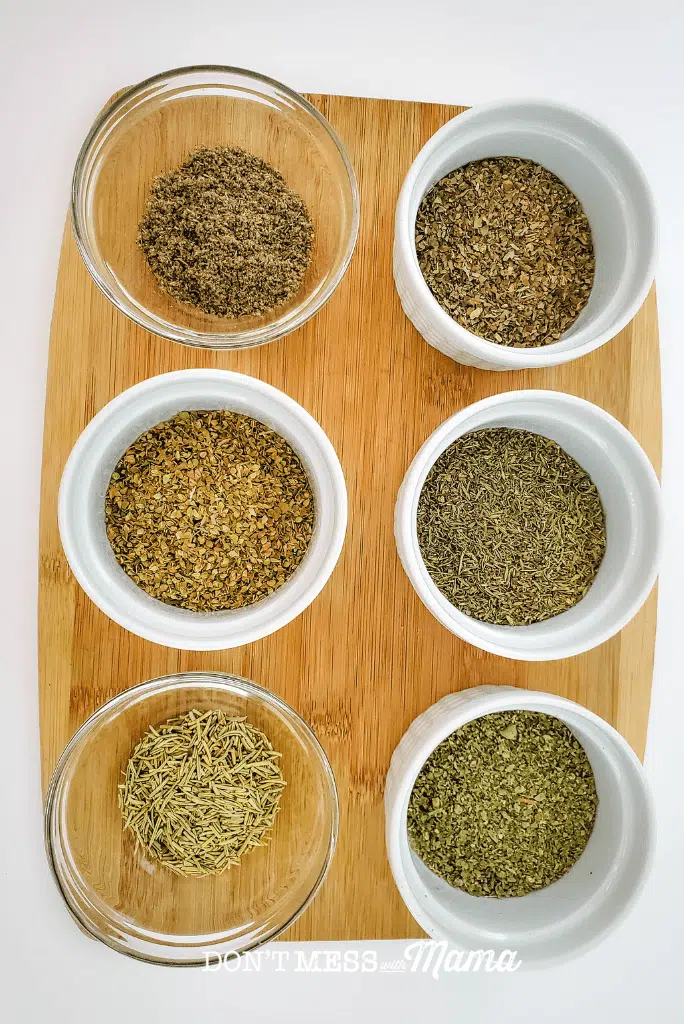
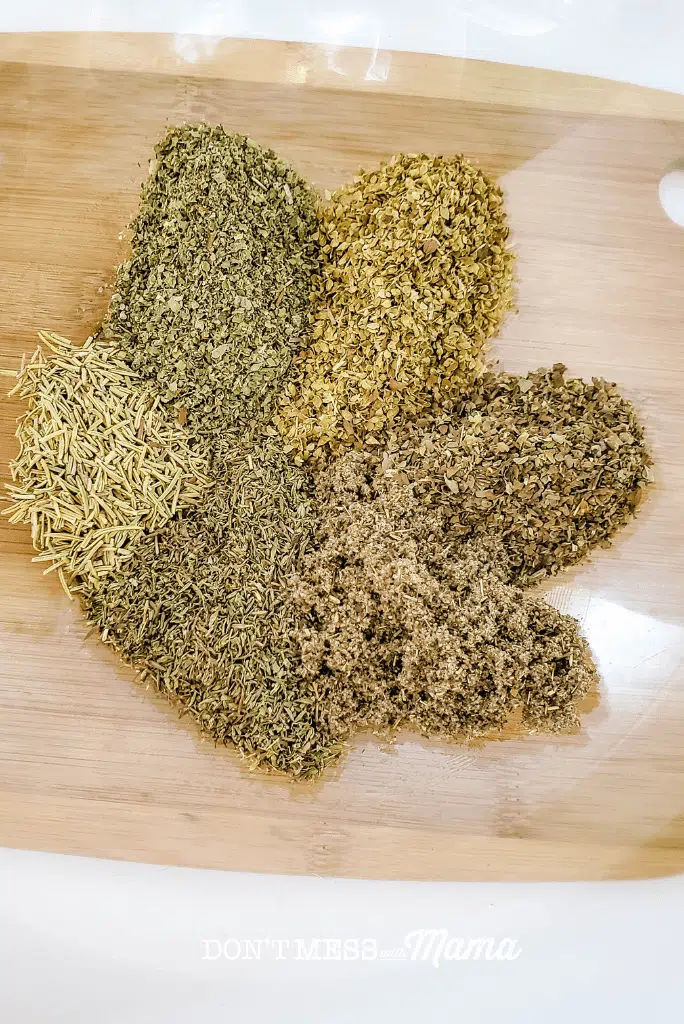

How to Use This Easy Italian Seasoning Blend
One of the many reasons I love an Italian seasoning blend is that it pairs well with SO many family favorites. Here are just a few ways I use it day to day:
- Add Italian Flair: Starting with the obvious, add authentic Italian flavor with ease to your favorite Italian recipes such as risotto, spaghetti and pizza.
- Sprinkle: A delicious way to jazz up your regular sides, sprinkle this easy Italian seasoning blend over vegetables or potatoes with a drizzle of olive oil or butter and roast until ready.
- Bake: Italian seasoning goes particularly well with cheese, so I love adding it to baked goods such as my gluten free cheddar biscuits and my cheese crackers recipe.
- Stir: Stir into your favorite soup recipes. It pairs particularly well with my instant pot tomato soup and my stuffed pepper soup. You could even add it to croutons if you make your own.
- Dressing & Marinades: If you’re in a pinch, mix Italian seasoning with olive oil and balsamic vinegar for a homemade Italian dressing, pair it with poultry like my delicious creamy lemon chicken or use as a Mediterranean-inspired marinade.
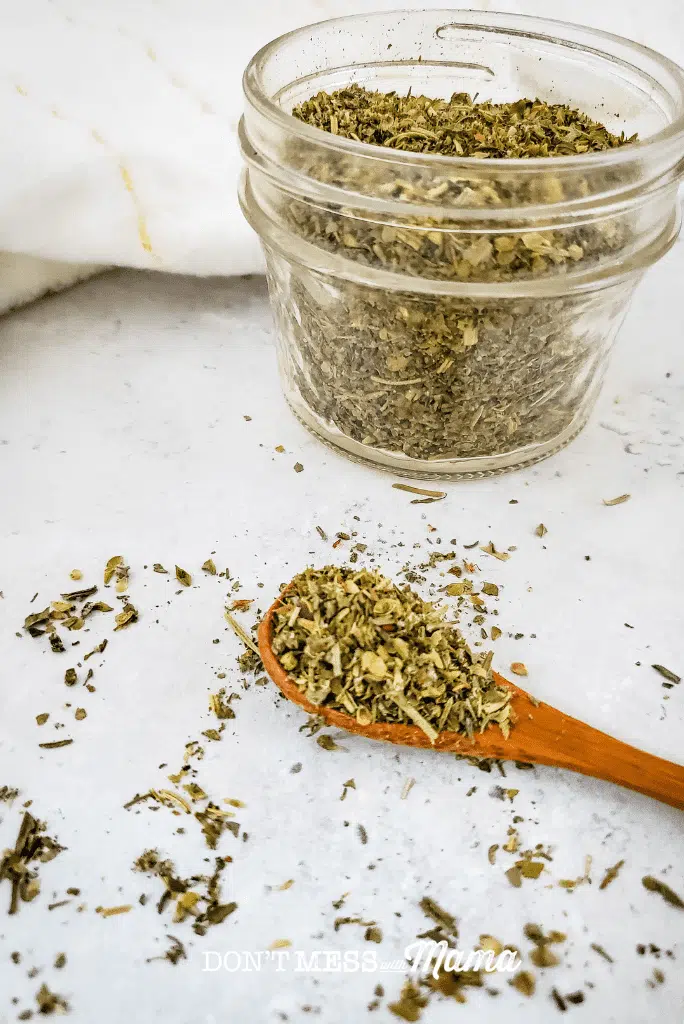
What are great additions to this Italian seasoning blend?
As mentioned, I kept this classic with herbs only. However, there are many other herbs and spices that can elevate this seasoning blend depending on your tastes. Some additions you could include are:
- Cilantro
- Sea salt
- Dried parsley
- Onion flakes
- Crushed red pepper flakes
- Garlic powder
- Paprika
What is the best way to store homemade seasoning?
The joy of using dried herbs only means this Italian seasoning blend has a great shelf life if stored correctly. To ensure it stays fresh, store it in a cool, dry and dark place. When exposed to heat and light the herbs will lose their flavor and aroma faster. It will last around 6 months when stored in a sealed jar or container.
Make sure to also check the expiry dates of all your herbs before adding to the mix as this may determine a shorter or longer shelf life. You will know it has gone “off” as the seasoning will no longer be aromatic.
What is the difference between Italian seasoning and Herbs de Provence?
Some people use these seasoning blends interchangeably as both contain thyme, basil, rosemary, oregano and marjoram. Like Italian seasoning, Herbs de Provence is also an all-purpose seasoning used in Mediterranean dishes. The main difference however, is that Herbs de Provence may also contain chervil, fennel, dill or tarragon among other herbs.
Top Tips
- If your ingredients are brand new, the mix should last longer, around a year
- Do not store in a spice rack near your stove top as the heat from the stove can affect shelf life.
- If making a larger batch, ensure all ingredients’ amounts are kept equal for a balanced flavor.
More Recipes You Might Like
Have you tried this homemade Italian Seasoning? Don’t forget to comment below to let me know how it went. You can also FOLLOW ME on Facebook, Instagram and Pinterest.

Easy Italian Seasoning Blend
Ingredients
- 2 tbsp oregano
- 2 tbsp basil
- 2 tbsp rosemary
- 2 tbsp sage
- 2 tbsp marjoram
Instructions
- Add all ingredients to a bowl.
- Stir well using a dry spatula, whisk or spoon until the herbs are well combined.
- Add the Italian seasoning blend to an airtight container and store in a cool dry place.
